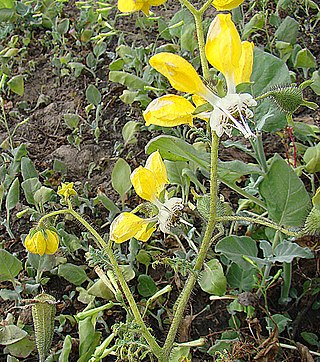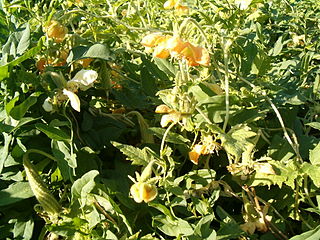
Loasaceae is a family of 15–20 genera and about 200–260 species of flowering plants in the order Cornales, native to the Americas and Africa. Members of the family include annual, biennial and perennial herbaceous plants, and a few shrubs and small trees. Members of the subfamily Loasoideae are known to exhibit rapid thigmonastic stamen movement when pollinators are present.
Ardisia schlechteri is a species of flowering plant in family Primulaceae. It is endemic to Cameroon. Its natural habitat is subtropical or tropical dry forests. It is threatened by habitat loss.
Begonia pseudoviola is a species of flowering plant in the family Begoniaceae. It is found in Cameroon and Nigeria. Its natural habitat is subtropical or tropical moist lowland forests. It is threatened by habitat loss.
Gentianella gilioides is a species of flowering plant in the family Gentianaceae. It is endemic to Ecuador. Its natural habitat is subtropical or tropical high-altitude shrubland.
Gentianella hypericoides is a species of flowering plant in the family Gentianaceae. It is endemic to Ecuador. Its natural habitat is subtropical or tropical high-altitude shrubland.
Gentianella longibarbata is a species of flowering plant in the family Gentianaceae. It is endemic to Ecuador. Its natural habitat is subtropical or tropical high-altitude grassland.
Gentianella splendens is a species of flowering plant in the family Gentianaceae. It is endemic to Ecuador. Its natural habitats are subtropical or tropical swamps and subtropical or tropical high-altitude shrubland.
Gentianella sulphurea is a species of flowering plant in the family Gentianaceae. It is endemic to Ecuador. Its natural habitat is subtropical or tropical high-altitude shrubland.
Halenia pulchella is a species of flowering plant in the family Gentianaceae. It is endemic to Ecuador. Its natural habitat is subtropical or tropical high-altitude grassland.
Marcgraviastrum gigantophyllum is a species of flowering plant in the family Marcgraviaceae. It is endemic to Ecuador. The vine's natural habitat is subtropical or tropical moist montane areas of the Andes Ecuadorian ranges.
Marcgraviastrum sodiroi is a species of plant in the Marcgraviaceae family endemic to Colombia and Ecuador.
Memecylon dasyanthum is a species of plant in the family Melastomataceae. It is endemic to Cameroon. Its natural habitat is subtropical or tropical moist montane forests. It is threatened by habitat loss.
Nasa aequatoriana is a species of flowering plant in the family Loasaceae. It is endemic to Ecuador. Its natural habitat is subtropical or tropical moist montane forests.
Nasa humboldtiana is a species of flowering plant in the familyLoasaceae. It is endemic to Ecuador. Its natural habitat is subtropical or tropical moist montane forests.

Nasa is a genus of plants in the family Loasaceae containing over 100 known species, all of which are found in South America with the exception of two species endemic to Central America. They are common in submontane to montane environments.

Halenia weddelliana is a species of flowering plant in the family Gentianaceae. Its natural habitat is subtropical or tropical high-altitude grassland.
Ophiobotrys zenkeri is a species of flowering plant in the family Salicaceae. It is a tree native to tropical Africa from Ivory Coast to Gabon and is the only member of the genus Ophiobotrys. Formerly classified in the Flacourtiaceae, phylogenetic analyses based on DNA data indicate that this species, along with its close relatives in the Asian genera Osmelia and Pseudosmelia, are better placed in a broadly circumscribed Salicaceae. Ophiobotrys differs from its close relatives in having 5 sepals, 5(-6) stamens, one divided style, and terminal inflorescences.
Blumenbachia is a genus of flowering plants belonging to the family Loasaceae.

Caiophora is a genus of flowering plants belonging to the family Loasaceae.
Pinnasa is a genus of flowering plants in the family Loasaceae. It includes seven species native to Argentina and central and southern Chile.




